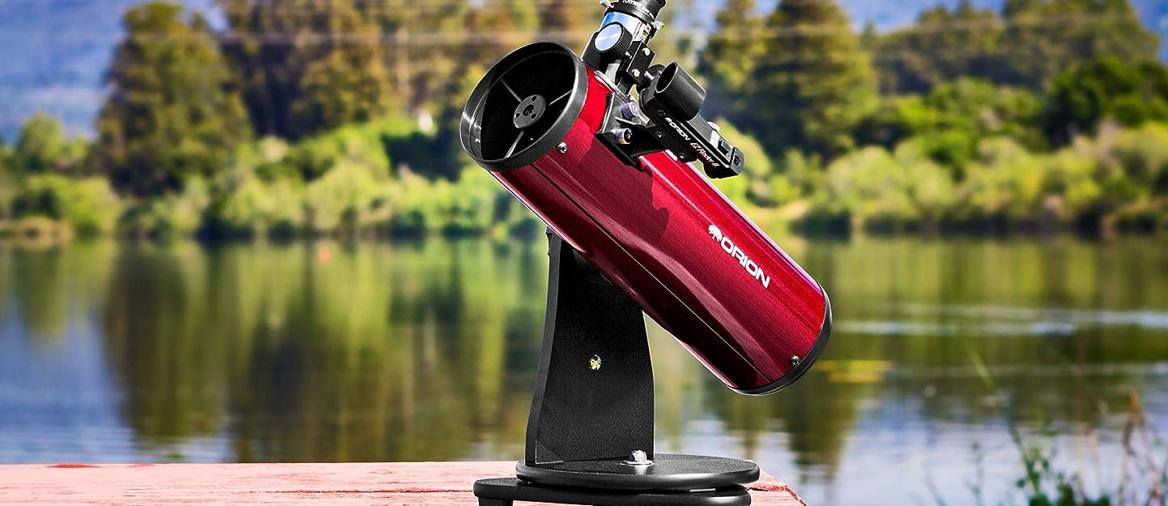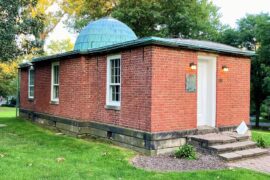A category of telescopes that is often overlooked is tabletop telescopes. These compact devices offer some of the benefits of powerful models in a very compact package. Here are some of the advantages of tabletop telescopes:
- Lightweight. They are much lighter than Newtonian telescopes of the same aperture.
- Portable. Their compact design makes them easy to bring with you. All you need is a stable surface to set them up.
- Stability. A table can be way more stable than a tripod. This is especially true for budget telescopes from manufacturers that tend to cut corners by using cheap materials.
- Easy assembly and storage. You won’t have to spend 5-10 minutes assembling them every time you want to use them.
- Easier to use indoors. This is great if you live in a generally cold area.
Thanks to all these reasons, a lot of people enjoy the idea of getting one of these models over something like a traditional Newtonian or something bulkier and heavier like a Dobsonian.
But how do you choose the perfect model for you? Well, the good news is that I have done all the homework for you. I have personally tested and compared over a dozen of the most popular tabletop telescope models and selected the best ones for various use cases.
The quick summary
If you just want to skip to the end results, here are the picks. Below, you will find more about the selection and testing process as well as a detailed review for each.
Best value – Orion Skyscanner 10012. A very solid entry-level telescope that offers decent power at an amazing price.
Best for beginners – Celestron StarSense Explorer 114mm tabletop Dobsonian. The built-in star mapping app and technology make the StarSense telescopes perfect for learning without hassle.
Best for enthusiasts – Sky-Watcher Heritage 130mm. Powerful device with excellent optics for those looking to take the next step into the hobby.
On a budget – Celestron Signature Series FirstScope. Low-powered but solid optics and build quality at a very reasonable price.
Best for kids under 8 – Sarblue Mak60. Easy to use and set up. Not very powerful but good enough to see the Moon, nearby planets, and nature.
Just show me the most powerful, I don’t care about the cost –Sky-Watcher Virtuoso GTI 150P. Excellent optics and a motorized GoTo base that can be controlled from your smartphone. The maximum aperture that you will find on a tabletop telescope.
Notes about tabletop telescopes
Here are a few random considerations and notes about tabletops telescope that you will also want to consider.
- If possible, don’t use them behind windows. I’ve said before that in general it is not recommended to use telescopes indoors but sometimes if you live in an apartment or in a very cold place, you just have to adapt. But even then, try not to use them through a window. Windows distorts the light too much even when they are perfectly clean. You will lose a lot of image quality, brightness and will get image artifacts.
- Use them on a sturdy table. At maximum magnification, telescopes can be very sensitive to even the slightest movement. Make sure you have a steady and balanced surface to use them on.
- At the end of the day, most tabletop telescopes are Newtonian or Dobsonian telescopes. These types of reflecting telescopes require occasional maintenance and mirror alignment. It is important to keep that in mind if a kid is going to be the main user as these telescopes require more active care than refracting telescopes which require zero maintenance.
How to choose a tabletop telescope
One of the advantages of getting a tabletop telescope is that the selection process is simpler than trying to buy a different type of scope.
For example, you will not have to select a type of mount as pretty much all tabletops will use a rotating Alt-Azimuth mount. Also, pretty much all tabletops are reflecting telescopes so you also won’t have to choose between a refractor and a reflector.
Your main concerns then will simply be two factors. Aperture and price.
The aperture of a telescope refers to the diameter of the primary mirror. In the case of reflecting telescopes, this is the mirror at the bottom of the tube. It is usually given in millimeters.
Most home telescopes range between 50mm and 200mm of aperture. The minimum aperture that I recommend for a beginner telescope is 70mm but you will not have to worry about that here as most tabletops are at least 100mm. You can check out this aperture comparison with photos so you can get an idea of what to expect out of each size.
Unless you plan to bring the telescope to the field, you won’t have to worry much about portability if you are going for a tabletop. This means that your main concern when choosing a tabletop telescope is to get the one with the largest aperture that your budget can support.
A larger aperture is always going to result in better images as it allows the telescope to capture more light, and therefore, extra detail.
There are, of course, exceptions to this rule. For example, if the telescope offers some additional functionality that you think is useful for you. For example, the StarSense telescope that you will find below as the best option for beginners comes with a star mapping feature that is very useful but makes it more expensive than other comparable models with the same aperture. In that case, it can be worth going for the functionality over aperture size.
Focal length and focal ratio don’t matter much when it comes to tabletops as these are not telescopes that are designed for astrophotography. Do not worry much about it.
Best tabletop telescopes
Best value – Orion SkyScanner 10012

A very solid entry-level telescope that offers decent power at an amazing price.
One of the main advantages of tabletop telescopes is that they usually offer large apertures for a smaller cost than a traditional tripod telescope. This is because manufacturing the rotating mounts of a tabletop is cheaper than a regular mount and tripod combo.
But even amongst tabletop telescopes, the Orion SkyScanner 10012 stands out for its amazing price-to-value ratio. This is a 100mm telescope at the price of a 70mm one.
While an aperture of 100mm is still considered entry-level, it is powerful enough to allow you to observe many celestial objects in detail.
The Moon is going to look great. You should be able to see every major crater in great detail as well as all of its major geological features. It even comes bundled with a Moon map that you can use as a guide.
Mars and Jupiter are great targets as well. For Mars, you will see some detail, and depending on the sky conditions and the closeness of the orbits, you might even get to see the poles. For Jupiter, you will see some of its distinguishable colored stripes and the largest moons, like Europa and Ganymede.
Saturn and its rings will be visible as well as Venus. Mercury is hard to see, even with professional telescopes as it is usually too close to the Sun and not very interesting, but under the right conditions, it is possible to observe it.
Uranus and Neptune are too far away to get any detail out of them. They are visible but you will just see a blue dot.
Many galaxies, nebulae, and star clusters are visible. The Orion SkyScanner can see objects with a magnitude (brightness) of 13.3. That includes many of the major galaxies like Andromeda, Bode’s Galaxy, The Triangulum galaxy, etcetera. Some other “can’t miss” objects like the Pillars of Creation in the Eagle Nebula are no problem either.
The optics of this telescope are solid. This is a reflector telescope, which means you will not get the chromatic (color) errors that you would see on a refracting model. The contrast and sharpness are good and while the images are a little bit dimmer than I would like, it is not a big deal.
The accessories are the only area where the SkyScanner 10012 doesn’t shine. It comes bundled with two Kellner eyepieces. A 10mm and a 20mm. These are serviceable but you might want to consider upgrading them at some point. It also doesn’t include a Barlow lens. I’d recommend looking into picking up a 3x Barlow like this one with it so you can get to high magnifications at a low cost.
Another valuable feature of the SkyScanner 100 is that despite being a tabletop, it can also connect to a tripod. It does not require a mount as you connect it with the base included and it can be used even with a camera tripod if it meets the weight requirement.
In general, the SkyScanner 10012 offers excellent value for the price. While some of the other models on this list are more powerful, none can beat the price-to-value ratio of this device. It is also often on sale which makes it even better.
Best for beginners – Celestron StarSense 114m Tabletop

The built-in star mapping app and technology make the StarSense telescopes perfect for learning without hassle.
The Celestron StarSense line of telescopes have been my top recommendation for beginners for a while now. Recently, they finally launched three tabletop models that include the functionality so here it is as my pick for this category.
Here’s how it works. All the StarSense telescopes come with a smartphone dock that is connected to the exit pupil of the telescope so you can see the resolved image either through an eyepiece like you normally would or on the screen.
Once the phone is attached, you can fire up the included app (works on Android and iOS) and it will ask you to follow some alignment instructions so it can know its position. Once it is aligned, the app will map out the sky and on your screen, it will add labels with the names of the stars and planets that you are looking at.
In the app database, you will be able to find a list of all the visible objects in the sky that night and once you select the one you want to look at, on-screen directions will appear so you can point the telescope and center it.
The StarSense technology eliminates the most difficult part for beginner stargazers which is getting used to the telescope controls and learning to locate objects in the sky. It is really a great tool that in my opinion should start to become standard for telescopes in the future.
The optics of the telescope are what you would expect from a reputable company like Celestron. They are good. The sharpness, contrast, and brightness are all great and I found no sign of visual aberrations.
The StarSense 114m is slightly pricier than other models of comparable specification because of the included StarSense technology. In my opinion, it is worth it as the application is extremely useful for a beginner and it does not come with any extra hidden fees or subscriptions.
There are larger StarSense tabletop models, a 130mm, and a 150mm if you are looking for more power. I think the 114mm has plenty of power if you are just starting out and the price increase for those models is a bit steep, but if you don’t mind the cost, they are great as well.
Best for enthusiasts – SkyWatcher Heritage 130mm

Powerful device with excellent optics for those looking to take the next step into the hobby.
If you are looking for a slightly more advanced model because you are upgrading or because you want something that is going to grow with you, check out the Heritage 130mm.
SkyWatcher is one of the most renowned brands when it comes to optics instruments. They are known for their high-quality products built for enthusiasts and professionals. This is the kind of company that doesn’t even make entry-level products. This means that every product stamped with their brand will be on the pricier side, but it is also going to be well-made.
If you go to an astronomy forum or Reddit and ask for a recommendation, well, first they’ll give you a thousand opinions on things you didn’t ask about, but then they’ll recommend you the SkyWatcher Heritage 130mm.
The specifications of the Heritage 130mm make it fit very well in the mid and high-mid range. With an aperture of 130mm, it is quite powerful and will allow you to see the extra details that you won’t get from models with smaller apertures. For example, in Saturn, you will finally be able to distinguish the space between the rings and the planet. On Mars, you can start to recognize some geological features and see the poles clearly. Nebulae and galaxies start to look great at this size if you want to get into astrophotography, this is a good aperture to begin with.
The design of the telescope has a collapsable piece. This is for extending the spider that holds the secondary mirror which results in also extending the focal length of the telescope. Extending the focal length reduces the field of view which is good for planetary viewing.
One of the best ways to tell that this telescope is aimed at a slightly more demanding audience are the built-in eyepieces. The Heritage 130mm comes with Plossl eyepieces (10mm and 25mm). Most telescopes come bundled with just Kellner eyepieces which have two optical elements inside. Those are usually good, but the next step in quality are Plossl eyepieces which have three, resulting in better light transmission and therefore, more brightness and slightly more detail.
The cost of the Heritage 130mm is not bad at all either. It is usually 10%-20% below a comparable tripod Newtonian with the same specs and quality.
You can’t go wrong with this telescope if you are looking for a balance between high-quality optics, power, and cost. The only problem with it is that it is consistently out of stock, especially during the holidays.
Best budget tabletop – Celestron Signature Series FirstScope
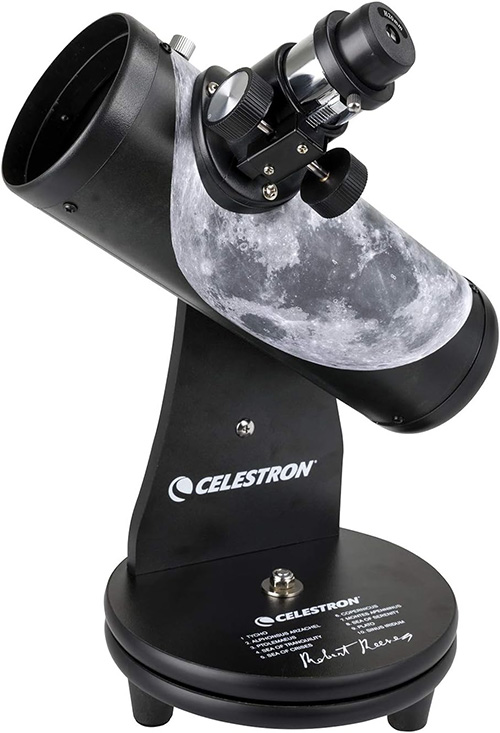
Low-powered but solid optics and build quality at a very reasonable price.
As the name suggests, the FirstScope is designed as a telescope for first-time users. It is a basic 76mm Newtonian reflector, making it by far the smallest model on this list.
However, an aperture of 76mm can still be very useful for basic stargazing. The Moon will still look great and all of the planets in the Solar system will be visible although the detail level will be limited.
As for deep-space observing, many of the brighter galaxies and star clusters can be observed even in the city (remember that due to light pollution, you will see fewer stars in the city than in rural areas). Pretty much all of the Messier objects should be visible, including the Andromeda Galaxy, The Pleiades, and the Orion Nebula. See this post about what to expect out of a 70mm telescope for some examples of what you might be able to observe.
Overall, the FirstScope is a good entry-level telescope. As long as you understand that it is a bit limited in power you will definitely have fun with it and the price is hard to beat.
Best for kids under 8 – SarBlue Mak60
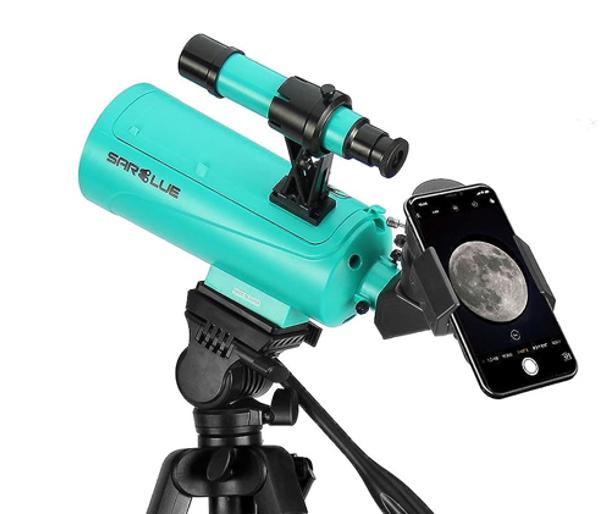
Easy to use and set up. Not very powerful but good enough to see the Moon, nearby planets, and nature.
When it comes to recommending the best tabletop telescope for young kids I can’t choose a Newtonian like the other items on this list. The reason is that those do require a bit of care and maintenance as they collect dust due to their open design. They also sometimes need to be aligned or collimated because the mirrors move as time passes. The process is easy, but it is not something a kid will want to do.
Instead, for this category I went with a Mak telescope, which is short for Maksutov-Cassegrain. These telescopes use a hybrid, closed design that is basically just “point-and-shoot”. The design also uses brighter colors to make it stand out.
The SarBlue Mak60 only has an aperture of 60mm. I know I said above that my minimum recommended aperture is 70mm but unfortunately, they don’t make these in larger sizes.
The magnification that this telescope can reach is quite limited. More than a stargazing device, this product is designed to be a terrestrial/nature telescope and maybe to occasionally look at the Moon, the closer planets, and the brightest galaxies. But don’t expect to get any detail out of anything other than the Moon.
The one thing that the Mak60 has going for it is that being a Maksutov telescope, the image quality is actually great and even better than many larger refractor telescopes. Thanks to its design, it does not show any of the color or spherical errors that those other models tend to show.
As for accessories, it includes a smartphone adapter which is great, but it only comes with one eyepiece. I would recommend getting a decent 10mm or 12mm eyepiece with it so you can at least try to get some extra detail and magnification out of it but don’t spend too much on it. A basic model like this one should be more than enough.
There isn’t much more to say about the Mak60. It is a telescope for kids to play and learn with or maybe to carry around on a hike to observe nature, but don’t expect too much out of it in terms of raw power.
Most powerful – SkyWatcher Virtuoso GTI 150P
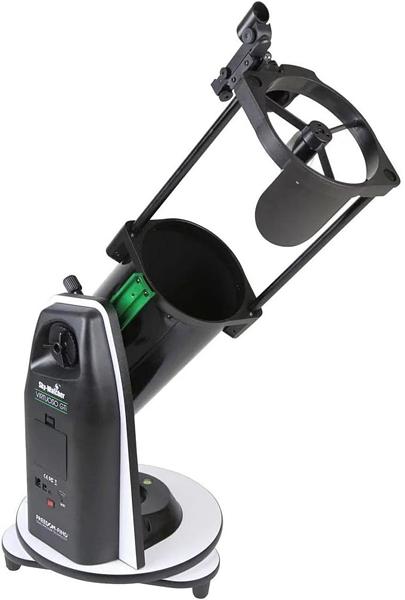
Excellent optics and a motorized GoTo base that can be controlled from your smartphone. The maximum aperture that you will find on a tabletop telescope.
The maximum aperture size that you will find on a tabletop telescope is 150mm. Any more than that would be too big and heavy and you’d have to be looking for a traditional Dobsonian instead.
In this category, the SkyWatcher Virtuoso is the best model I have ever tried.
The optics are crisp, sharp, and bright. The contrast is high, and I didn’t find any noticeable aberrations.
An aperture of 150mm is going to allow you to see objects with a magnitude (brightness) of 14.1. That includes dozens of galaxies, nebulae, and star clusters that are not visible on smaller models.
At this size, Mars and Jupiter start to show a lot more details, colors, and regions. Even the small details on the surface of the Moon are recognizable. This is the aperture range where you start to see professional photos of the Moon.
The optic quality of all SkyWatcher products is great. This is one of the most trusted brands on the market, but that’s not even the best feature.
You might notice in the photos the control panel and entry ports on the side of the base. That is because the SkyWatcher Virtuoso comes with a fully motorized GoTo mount that connects via WiFi to your phone to get a map of the sky (it can be powered using batteries or a 12V power supply). This allows it to automatically locate any object in the sky for that night. All you need to do is align it once at the beginning of your session and the rest can be handled through the included smartphone app. Just select the object that you want to see and the telescope will automatically move towards it.
GoTo mounts make stargazing so easy as you no longer need to worry about locating the objects that you want to observe. The problem is that generally, they are prohibitively expensive, however, they have been coming down in price in later years, and since tabletops don’t require a sturdy tripod, they can be included at a more reasonable price.
If your budget allows for it, the SkyWatcher Virtuoso GTI 150P is the best telescope on this list. There is also a 130mm model but the price difference isn’t too big so the 150mm offers better value in my opinion.
Enjoyed this article?
Get daily 10-minute PDFs about astronomy to read before bed!
Sign up for our upcoming micro-learning service where you will learn something new about space and beyond every day while winding down.

